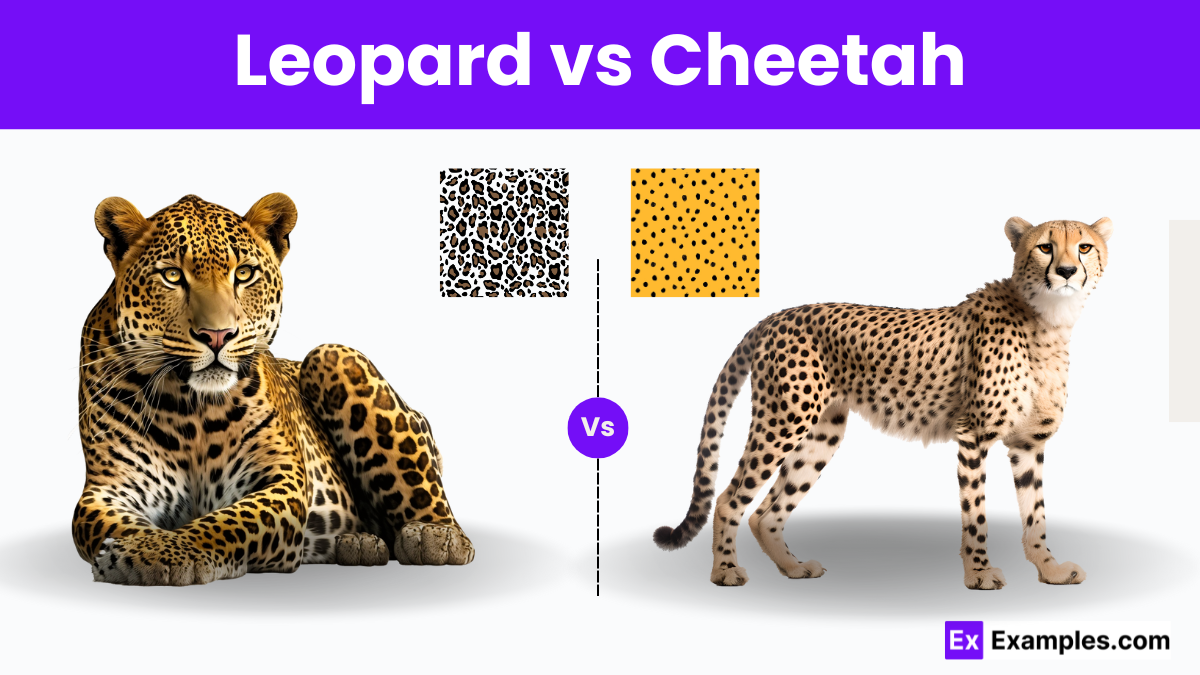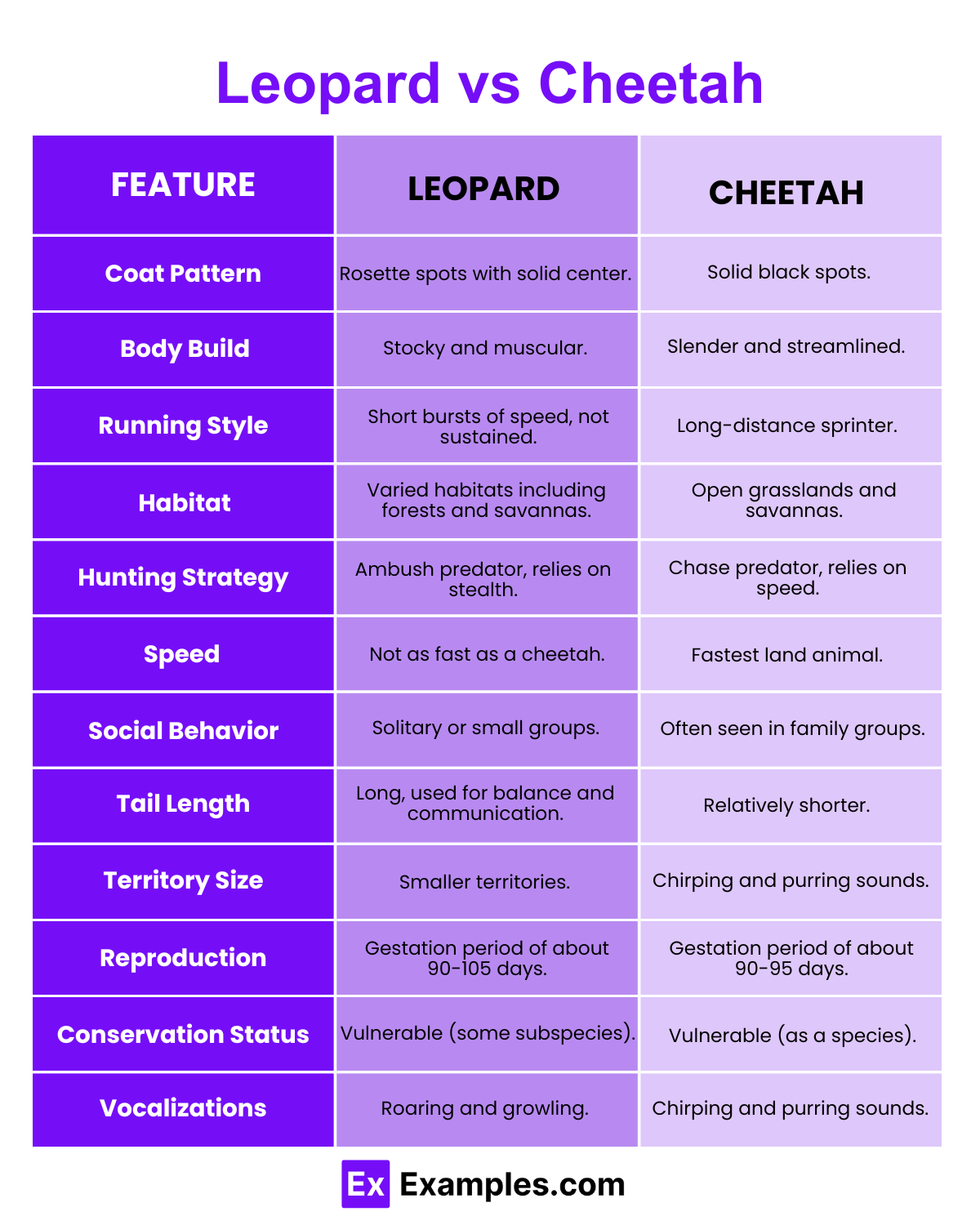Which of the following physical characteristics helps differentiate a cheetah from a leopard?
Solid black spots
Rosette-shaped spots
Long tail
Round face

The majestic landscapes of Africa are home to two of the most iconic big cats: the leopard and the cheetah. While they may appear similar at first glance, these predators have distinct traits and lifestyles that set them apart. This article delves into the unique characteristics, hunting methods, and ecological roles of each species. By understanding the differences between leopards and cheetahs, we can appreciate their significance in the natural world and emphasize the importance of their conservation. Let’s explore the fascinating contrasts and occasional similarities between these two remarkable animals.
Leopards (Panthera pardus) are distinguished by their adaptability to various habitats, including forests, mountains, and grasslands across Africa and parts of Asia. Recognizable for their rosette-patterned coat, these solitary predators are versatile hunters that exhibit remarkable strength, often hauling prey much larger than themselves into trees to avoid scavengers. Leopards are nocturnal creatures, primarily active at night, which aids in their stealth and effectiveness as apex predators in their environments.
Cheetahs (Acinonyx jubatus), known for being the fastest land animals, can reach speeds up to 60-70 mph in short bursts covering distances up to 1,500 feet. Inhabiting various African savannas and a small population in Iran, these slender felines are adapted for speed with their lightweight frame, long legs, and specialized muscles. Unlike other big cats, cheetahs hunt primarily during the day to avoid larger predators and rely on their exceptional speed and keen eyesight to catch prey, primarily focusing on small to medium-sized ungulates.

| Characteristic | Leopard | Cheetah |
|---|---|---|
| Appearance | Leopards have a robust build with short legs and a long body. Their fur is marked with rosettes. | Cheetahs are slender with long legs and a streamlined body. They have distinctive black “tear” lines running from the eye to the mouth and their coat is covered with solid black spots. |
| Habitat | Prefer dense bush where they can hide and ambush prey. They are adaptable and found in various habitats including forests, mountains, and grasslands. | Favor open savannas and grasslands which suit their high-speed chases. |
| Hunting Strategy | Stalk and ambush predators that rely on stealth and strength to tackle larger prey. They often drag their food up trees to avoid scavengers. | Chase predators known for their incredible speed, reaching up to 60-70 mph in short bursts covering distances up to 1,500 feet. They use speed over short distances to catch prey. |
| Social Behavior | Mostly solitary, except during mating season or when females are raising cubs. | Less territorial than leopards, often seen with siblings or mothers with cubs. Males sometimes form small groups called coalitions. |
| Speed | Not particularly fast compared to other big cats, reaching speeds of about 36 mph. | Exceptionally fast, the fastest land animal, reaching speeds of up to 70 mph. |
| Climbing Ability | Excellent climbers that often carry their food into trees to protect it from other predators. | Poor climbers compared to leopards. They do not typically climb trees. |
| Distribution | Widespread across sub-Saharan Africa, parts of Asia, and the Middle East. | Predominantly found in sub-Saharan Africa with a small population in Iran. |
| Conservation Status | Listed as Vulnerable on the IUCN Red List; their populations are threatened by habitat loss and poaching. | Listed as Vulnerable; facing threats from habitat loss and the illegal pet trade. |
| Diet | Opportunistic feeders eating a variety of prey including deer, warthogs, and rodents. They can adapt to local prey availability. | Primarily eat medium-sized ungulates, such as gazelles and impalas. They require a diet rich in nutrients from fresh kills. |
| Reproductive Behavior | Females are solitary with cubs, hiding them in dense vegetation until they are old enough to follow her. Gestation lasts about 90-105 days. | Females raise their cubs in open areas where they can easily observe potential threats. Gestation lasts about 90 days. |
| Nocturnal Activity | Primarily nocturnal, they are most active during the night when they hunt and move between territories. | Mostly diurnal, preferring to hunt in the early morning and late afternoon to avoid the midday heat. |
| Vocalization | Utilize a variety of vocalizations including growls, snarls, and purrs, particularly during social interactions and territorial disputes. | Known for a high-pitched chirp or call, which is used to locate each other or signal distress, especially by cubs. |
Leopards and cheetahs share several similarities, reflecting their classification within the Felidae family, which includes other big cats. Here are some key similarities:
Leopards have rosette spots and are stronger climbers, while cheetahs have solid spots and excel in speed.
Yes, a leopard can defeat a cheetah due to its superior strength and more robust build.
Cheetahs are faster than leopards, achieving speeds up to 70 mph in short bursts.
Cheetahs and leopards have spotted coats; panthers, a term for melanistic leopards or jaguars, have dark, solid coats.
Leopards are more aggressive, exhibiting stronger territorial behavior and less avoidance of conflict compared to cheetahs.
Text prompt
Add Tone
10 Examples of Public speaking
20 Examples of Gas lighting
Which of the following physical characteristics helps differentiate a cheetah from a leopard?
Solid black spots
Rosette-shaped spots
Long tail
Round face
Which of the following is true about a cheetah's speed?
Cheetahs are slower than leopards.
Cheetahs can run up to 60-70 mph.
Cheetahs are the same speed as leopards.
Cheetahs cannot run fast.
Leopards are known for their ability to:
Run faster than cheetahs
Climb trees
Swim long distances
Live in large social groups
Which of the following habitats is preferred by leopards?
Open plains
Dense forests and mountains
Arctic tundra
Deserts
Cheetahs primarily hunt during:
Early morning and late afternoon
Night
Any time of the day
Midday
Which of the following best describes a cheetah’s body build?
Muscular and stocky
Heavy and robust
Short and compact
Slender and lightweight
How do leopards primarily catch their prey?
By running them down in open chase
By ambush and stealth
By working in groups
By setting traps
Which of the following social structures is typical of cheetahs?
Solitary except for mating and rearing cubs
Permanent pairs
Large pride-like groups
Constantly shifting groups
Leopards are more likely to be found in which continents?
Antarctica and Australia
North America and Europe
Africa and Asia
South America and Oceania
Cheetahs’ claws are:
Fully retractable
Partially retractable
Non-retractable
Absent
Before you leave, take our quick quiz to enhance your learning!

